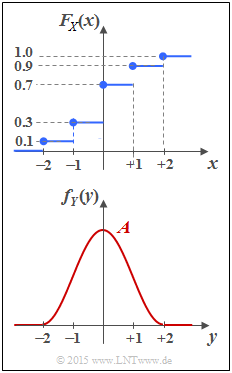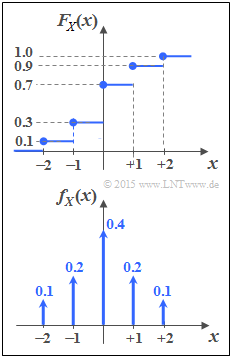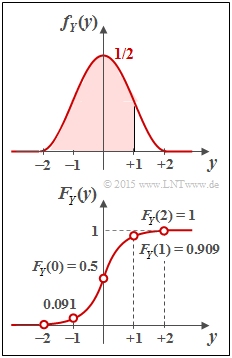Difference between revisions of "Aufgaben:Exercise 4.1: PDF, CDF and Probability"
| Line 3: | Line 3: | ||
}} | }} | ||
| − | [[File:P_ID2862__Inf_A_4_1_neu.png|right|frame| | + | [[File:P_ID2862__Inf_A_4_1_neu.png|right|frame|CDF (top) and PDF (bottom)]] |
| − | + | To repeat some important basics from the book "Theory of Stochastic Signals" | |
beschäftigen wir uns mit | beschäftigen wir uns mit | ||
| − | * | + | * the [[Theory_of_Stochastic_Signals/Wahrscheinlichkeitsdichtefunktion|probability density function]] (PDF), |
| − | * | + | * the [[Theory_of_Stochastic_Signals/Verteilungsfunktion|cumulative distribution function]] (CDF). |
| − | + | The upper plot shows the distribution function $F_X(x)$ of a discrete value random variable $X$. The corresponding PDF $f_X(x)$ has to be determined in subtask '''(1)''' . | |
| − | + | The equation | |
:$$ {\rm Pr}(A < X \le B) = F_X(B) - F_X(A) = \lim_{\varepsilon \hspace{0.05cm}\rightarrow \hspace{0.05cm}0} \int_{A+\varepsilon}^{B+\varepsilon} \hspace{-0.15cm} f_X(x) \hspace{0.1cm}{\rm d}x $$ | :$$ {\rm Pr}(A < X \le B) = F_X(B) - F_X(A) = \lim_{\varepsilon \hspace{0.05cm}\rightarrow \hspace{0.05cm}0} \int_{A+\varepsilon}^{B+\varepsilon} \hspace{-0.15cm} f_X(x) \hspace{0.1cm}{\rm d}x $$ | ||
| − | + | represents two ways to calculate the probability for the event „The random variable $X$ lies in a given interval” from the CDF and the PDF, respectively. | |
| − | + | The lower graph shows the probability density function | |
:$$ f_Y(y) = \left\{ \begin{array}{c} \hspace{0.1cm}1/2 \cdot \cos^2(\pi/4 \cdot y) \\ \hspace{0.1cm} 0 \\ \end{array} \right.\quad \begin{array}{*{20}c} {\rm{f\ddot{u}r}} \\ {\rm{f\ddot{u}r}} \\ \end{array}\begin{array}{*{20}l} | y| \le 2, \\ | :$$ f_Y(y) = \left\{ \begin{array}{c} \hspace{0.1cm}1/2 \cdot \cos^2(\pi/4 \cdot y) \\ \hspace{0.1cm} 0 \\ \end{array} \right.\quad \begin{array}{*{20}c} {\rm{f\ddot{u}r}} \\ {\rm{f\ddot{u}r}} \\ \end{array}\begin{array}{*{20}l} | y| \le 2, \\ | ||
y < -2 \hspace{0.1cm}{\rm und}\hspace{0.1cm}y > +2 \\ \end{array}$$ | y < -2 \hspace{0.1cm}{\rm und}\hspace{0.1cm}y > +2 \\ \end{array}$$ | ||
| − | + | of a continuous-valued random variable $Y$, which is restricted to the range $|Y| \le 2$ . | |
| + | In principle, the same relationship between PDF, CDF and probabilities exists for the continuous random variable $Y$ as for a discrete random variable. Nevertheless, you will notice some differences in details. | ||
| − | + | For example, for the continuous random variable $Y$ , the boundary transition can be omitted in the above equation, and we obtain simplified: | |
| − | |||
| − | |||
:$${\rm Pr}(A \le Y \le B) = F_Y(B) - F_Y(A) =\int_{A}^{B} \hspace{-0.01cm} f_Y(y) | :$${\rm Pr}(A \le Y \le B) = F_Y(B) - F_Y(A) =\int_{A}^{B} \hspace{-0.01cm} f_Y(y) | ||
\hspace{0.1cm}{\rm d}y\hspace{0.05cm}.$$ | \hspace{0.1cm}{\rm d}y\hspace{0.05cm}.$$ | ||
| Line 36: | Line 35: | ||
| − | + | Hints: | |
| − | * | + | *The task belongs to the chapter [[Information_Theory/Differentielle_Entropie|Differential Entropy]]. |
| − | * | + | *Useful hints for solving this problem and further information on continuous-valued random variables can be found in the third chapter "Continuous Random Variables" of the book [[Theory of Stochastic Signals]]. |
| − | * | + | *Given also is the following indefinite integral: |
:$$\int \hspace{0.1cm} \cos^2(A \eta) \hspace{0.1cm}{\rm d}\eta = \frac{\eta}{2} + \frac{1}{4A} \cdot \sin(2A \eta).$$ | :$$\int \hspace{0.1cm} \cos^2(A \eta) \hspace{0.1cm}{\rm d}\eta = \frac{\eta}{2} + \frac{1}{4A} \cdot \sin(2A \eta).$$ | ||
| − | === | + | ===Questions=== |
<quiz display=simple> | <quiz display=simple> | ||
Revision as of 22:51, 23 September 2021
To repeat some important basics from the book "Theory of Stochastic Signals" beschäftigen wir uns mit
- the probability density function (PDF),
- the cumulative distribution function (CDF).
The upper plot shows the distribution function $F_X(x)$ of a discrete value random variable $X$. The corresponding PDF $f_X(x)$ has to be determined in subtask (1) .
The equation
- $$ {\rm Pr}(A < X \le B) = F_X(B) - F_X(A) = \lim_{\varepsilon \hspace{0.05cm}\rightarrow \hspace{0.05cm}0} \int_{A+\varepsilon}^{B+\varepsilon} \hspace{-0.15cm} f_X(x) \hspace{0.1cm}{\rm d}x $$
represents two ways to calculate the probability for the event „The random variable $X$ lies in a given interval” from the CDF and the PDF, respectively.
The lower graph shows the probability density function
- $$ f_Y(y) = \left\{ \begin{array}{c} \hspace{0.1cm}1/2 \cdot \cos^2(\pi/4 \cdot y) \\ \hspace{0.1cm} 0 \\ \end{array} \right.\quad \begin{array}{*{20}c} {\rm{f\ddot{u}r}} \\ {\rm{f\ddot{u}r}} \\ \end{array}\begin{array}{*{20}l} | y| \le 2, \\ y < -2 \hspace{0.1cm}{\rm und}\hspace{0.1cm}y > +2 \\ \end{array}$$
of a continuous-valued random variable $Y$, which is restricted to the range $|Y| \le 2$ . In principle, the same relationship between PDF, CDF and probabilities exists for the continuous random variable $Y$ as for a discrete random variable. Nevertheless, you will notice some differences in details.
For example, for the continuous random variable $Y$ , the boundary transition can be omitted in the above equation, and we obtain simplified:
- $${\rm Pr}(A \le Y \le B) = F_Y(B) - F_Y(A) =\int_{A}^{B} \hspace{-0.01cm} f_Y(y) \hspace{0.1cm}{\rm d}y\hspace{0.05cm}.$$
Hints:
- The task belongs to the chapter Differential Entropy.
- Useful hints for solving this problem and further information on continuous-valued random variables can be found in the third chapter "Continuous Random Variables" of the book Theory of Stochastic Signals.
- Given also is the following indefinite integral:
- $$\int \hspace{0.1cm} \cos^2(A \eta) \hspace{0.1cm}{\rm d}\eta = \frac{\eta}{2} + \frac{1}{4A} \cdot \sin(2A \eta).$$
Questions
Musterlösung
(1) Richtig sind die Lösungsvorschläge 1 und 2:
- Die Verteilungsfunktion (VTF) $F_X(x)$ ergibt sich aus der Wahrscheinlichkeitsdichtefunktion $f_X(x)$ durch Integration über die (umbenannte) Zufallsgröße im Bereich von $- \infty$ bis $x$.
- Die Umkehrung lautet: Ist die VTF gegeben, so erhält man die WDF durch Differentiation.
- Die vorgegebene VTF beinhaltet fünf Unstetigkeitsstellen, die nach der Differentiation zu fünf Diracfunktionen führen:
- $$f_X(x) = 0.1 \cdot {\rm \delta}( x+2) + 0.2 \cdot {\rm \delta}( x+1) + 0.4 \cdot {\rm \delta}( x) + 0.2 \cdot {\rm \delta}( x-1) + 0.1 \cdot {\rm \delta}( x-2)\hspace{0.05cm}.$$
- Die Diracgewichte geben die Auftrittswahrscheinlichkeiten der Zufallsgröße $X = \{-2,\ -1,\ 0,\ +1,\ +2\}$ an,
zum Beispiel:
- $${\rm Pr}(X = 0) = F_X(x \hspace{0.05cm}\rightarrow\hspace{0.05cm}0^{+}) - F_X(x \hspace{0.05cm}\rightarrow\hspace{0.05cm}0^{-}) = 0.7 - 0.3 = 0.4\hspace{0.05cm}.$$
- Dementsprechend lauten die weiteren Wahrscheinlichkeiten:
- $${\rm Pr}(X = +1) = {\rm Pr}(X = -1) = 0.2\hspace{0.05cm},\hspace{0.3cm} {\rm Pr}(X = +2) = {\rm Pr}(X = -2) = 0.1\hspace{0.05cm}.$$
(2) Aus der eben berechneten WDF erhält man:
- $${\rm Pr}(X >0) = {\rm Pr}(X = +1) + {\rm Pr}(X = +2) \hspace{0.15cm}\underline {= 0.3}\hspace{0.05cm},$$
- $${\rm Pr}(|X| \le 1) ={\rm Pr}(X = -1) + {\rm Pr}(X = 0) + {\rm Pr}(X = +1) = 0.2 + 0.4 +0.2 \hspace{0.15cm}\underline {= 0.8}\hspace{0.05cm}.$$
Zum gleichen Ergebnis kommt man über die Verteilungsfunktion. Hier lautet die allgemeine Gleichung, die für wertdiskrete und wertkontinuierliche Zufallsgrößen gleichermaßen gilt:
- $${\rm Pr}(A < X \le B) =F_X(B) - F_X(A) \hspace{0.05cm}.$$
- Mit $A= 0$ und $B = +2$ erhält man somit:
- $${\rm Pr}(0 < X \le +2) = {\rm Pr}(X >0)= F_X(+2) - F_X(0) = 1 - 0.7 \hspace{0.15cm}\underline {= 0.3} \hspace{0.05cm}.$$
- Setzt man $A=-2$ und $B = +1$, so ergibt sich:
- $${\rm Pr}(-2 < X \le +1) = {\rm Pr}(|X| \le 1)= F_X(+1) - F_X(-2) = 0.9 - 0.1 \hspace{0.15cm}\underline {= 0.8} \hspace{0.05cm}.$$
(3) Die Verteilungsfunktion $F_Y(y)$ ergibt sich aus der (umbenannten) WDF $f_Y(\eta)$ durch Integration von $- \infty$ bis $x$. Aufgrund der Symmetrie kann hierfür im Bereich $0 \le y \le +2$ geschrieben werden:
- $$F_Y(y) = \int_{-\infty}^{\hspace{0.05cm}y} \hspace{-0.1cm}f_Y(\eta) \hspace{0.1cm}{\rm d}\eta ={1}/{2}+\int_{0}^{\hspace{0.05cm}y} \hspace{-0.1cm}f_Y(\eta) \hspace{0.1cm}{\rm d}\eta$$
- $$\Rightarrow \hspace{0.3cm}F_Y(y) = \frac{1}{2}+\int_{0}^{\hspace{0.05cm}y} \hspace{0.1cm}\frac{1}{2} \cdot \cos^2({\pi}/{4} \cdot \eta) \hspace{0.1cm}{\rm d}\eta = \frac{1}{2}+\frac{y}{4} + \frac{1}{2\pi} \cdot \sin({\pi}/{2} \cdot y).$$
Die Gleichung gilt im gesamten Bereich $0 \le y \le +2$. Die gesuchten VTF–Werte sind damit:
- $F_Y(y=0)\hspace{0.15cm}\underline{= 0.5}$ (Integral über die halbe WDF),
- $F_Y(y=1)= 3/4 + 1/(2 \pi)\hspace{0.15cm}\underline{= 0.909}$ (rot hinterlegte Fläche in der WDF),
- $F_Y(y=2)\hspace{0.15cm}\underline{= 1}$ (Integral über die gesamte WDF).
(4) Die Wahrscheinlichkeit, dass die wertkontinuierliche Zufallsgröße $Y$ im Bereich von $-\varepsilon$ bis $+\varepsilon$ liegt, kann mit der angegebenen Gleichung wie folgt berechnet werden:
- $${\rm Pr}(-\varepsilon \le Y \le +\varepsilon) = F_Y(+\varepsilon) - F_Y(-\varepsilon) \hspace{0.05cm}.$$
- Berücksichtigt wurde, dass man bei der kontinuierlichen Zufallsgröße $Y$ das "<"–Zeichen ohne Verfälschung durch das "≤"–Zeichen ersetzen kann.
- Mit dem Grenzübergang $\varepsilon \to 0$ ergibt sich die gesuchte Wahrscheinlichkeit:
- $${\rm Pr}(Y = 0) =\lim_{\varepsilon\hspace{0.05cm}\rightarrow\hspace{0.05cm}0}\hspace{0.1cm}{\rm Pr}(-\varepsilon \le Y \le +\varepsilon) = \lim_{\varepsilon\hspace{0.05cm}\rightarrow\hspace{0.05cm}0}\hspace{0.1cm} F_Y(+\varepsilon) - \lim_{\varepsilon\hspace{0.05cm}\rightarrow\hspace{0.05cm}0}\hspace{0.1cm} F_Y(-\varepsilon) = F_Y(y \hspace{0.05cm}\rightarrow\hspace{0.05cm}0^{+}) - F_Y(y \hspace{0.05cm}\rightarrow\hspace{0.05cm}0^{-})\hspace{0.05cm}.$$
- Da bei einer kontinuierlichen Zufallsgröße die beiden Grenzwerte gleich sind, gilt $\underline{{\rm Pr}(Y = 0) = 0}$.
Allgemein gilt: Die Wahrscheinlichkeit ${\rm Pr}(Y = y_0)$, dass eine wertkontinuierliche Zufallsgröße $Y$ einen festen Wert $y_0$ annimmt, ist stets Null.
(5) Richtig ist der Lösungsvorschlag 2:
- Aufgrund der vorliegenden WDF kann das Ergebnis $Y=3$ ausgeschlossen werden.
- Das Ergebnis $Y=0$ ist dagegen durchaus möglich, obwohl ${\rm Pr}(Y = 0) = 0$ ist.
- Führt man zum Beispiel ein Zufallsexperiment $N \to \infty$ mal durch und erhält dabei $N_0$ mal das Ergebnis $Y= 0$, so gilt bei endlichem $N_0$ nach der klassischen Definition der Wahrscheinlichkeit:
- $${\rm Pr}(Y = 0) = \lim_{N\hspace{0.05cm}\rightarrow\hspace{0.05cm}\infty}\hspace{0.1cm}{N_0}/{N} = 0\hspace{0.05cm}.$$
(6) Wir gehen wieder von der von der für die kontinuierliche Zufallsgröße $Y$ gültigen Gleichung $ {\rm Pr}(A \le Y \le B) = F_Y(B) - F_Y(A)$ aus:
- Mit $A = 0$ und $B \to \infty$ $($bzw. $B = 2)$ erhält man:
- $${\rm Pr}( Y > 0) = {\rm Pr}(0 \le Y \le \infty) = {\rm Pr}(0 \le Y \le 2) = F_Y(2) - F_Y(0) \hspace{0.15cm}\underline {= 0.5}\hspace{0.05cm}.$$
- Bei der symmetrischen kontinuierlichen Zufallsgröße $Y$ ist also tatsächlich erwartungsgemäß ${\rm Pr}( Y > 0) = 1/2$.
- Obwohl auch die wertdiskrete Zufallsgröße $X$ symmetrisch um $x= 0$ ist, wurde in der Teilaufgabe (3) dagegen ${\rm Pr}( X > 0) = 0.3$ ermittelt.
- Weiter erhält man mit $A = -1$ und $B = +1$ wegen $F_Y(-1) = 1- F_Y(+1)$:
- $${\rm Pr}( |Y| \le 1) = {\rm Pr}(-1 \le Y \le +1) = F_Y(+1) - F_Y(-1) = 2 \cdot F_Y(+1) -1 = 2 \cdot 0.909 -1 \hspace{0.15cm}\underline {= 0.818}. $$


